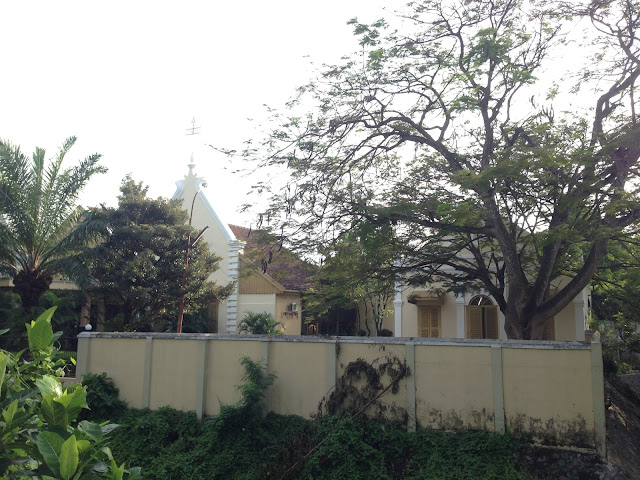HVA HOSPITAL, PARE-KEDIRI
For some people who ever stayed in
Pare-Kediri might aware about one of the best healtcare facilities for public
named HVA hospital. This hospital located in 25 Ahmad Yani street, Tulungrejo, Pare,
Kediri which is adjacent to the city centre of Pare. As I explained before on
the previous article, the building used for hospital has magnificent
arcitecture that popular in early XX century. this building amazed me because I
never expect that it situated in Pare that actually not a big city. I guess
this building was built when the dutch government still occupied this country
in 1900’s. However, I do not know about the previous function of this building
before becoming a hospital, or this building was intended for hospital since
the beginning of its contruction (I have to find further information to prove
this). It might become a fascinating
thing to observe this building to know the interseting story from the past.
 |
| Doc. Abel Jatayu P Pare, Kediri. |
From Thursday (9/11/17) until Saturday (10/11/17) I tried to find some sources to reconstruct the history of HVA hospital, then I got a sufficient sources to explain about the story of this building through several ways such as asking my friends who concern about collonial architecture, and surfing in the internet to access several websites, private blogs and online archieves that provide information relating to this building. The sources that I found were amazing which can give me depiction about the situation of Pare during colonial era. Through those sources I just knew that HVA is an abbreviation of NV. Handels Vereeniging Amsterdam, it was the private trading company in the field of plantation which was ran by dutch.
 |
| HVA symbol |
NV. Handels Vereeniging Amsterdam was founded in 1873 and was one of the largest colonial companies in the world with 170,000 workers in 1928. This company was founded in order to rebuild the economic conditions after Java war or Diponegoro war (1825-1830) which cost a lot of money. In Sumatra, this company managed 4 main comodities through 16 production units that are Palm oil plantations, tea plantations, and rubber plantations. In Java HVA managed 4 main comodities through 23 production units- 16 sugarcane factories (Djatiroto I, Djatiroto I, Goenoengsari, Semboro, Bedadoeng, Mingiran, Kawarasan, Kentjong, Menang, Blimbing, Garoem, Tegowangi, Soemberdadie, Ngadiredjo, Koenir, Sroenie), 3 Kebun Tapioka dan Serat (Bendoredjo, Djengkol, Toeren), 3 rubber plantations (Soember Petoeng, Redjo Agoeng, Papoh), 1 coffee plantation (Njoenjoer).
It was reasonable that sugar cane plantations and factories which situated surrounding Pare influenced the local livelihoods to be a worker of HVA company. In that time, HVA had aware to the health condition of the workers which was in line to the company condition as well. Therefore, in 1908 this company built several hospitals which one of them located in Pare, Toeloengredjo to facilitate his workers. The presence of this company in Pare was automaticaly stimulate the economic improvement in this area which also had an impact to the good condition of local people’s live. European people also built public facilities to support their lives for example schools, train station, and electricity.
 |
| European school in Pare in 1900's |
 |
| source: Troppenmuseum HVA pare, Kediri |
In 27 December 1958, Seokarno (the first president of Indonesia) signed regulation to nationalize all of the dutch companies in Indonesia. Starting from this time, the capital assets of HVA companies also was owned by the government of Indonesia. Those might be the story from the past about HVA Hospital in Pare that I can deliver to you. thanks for coming in this blog.
Kamar Salatiga, 16 December 2017
Abel Jatayu Prakosa



Comments
Post a Comment